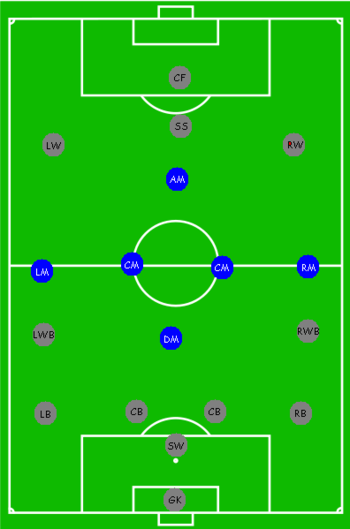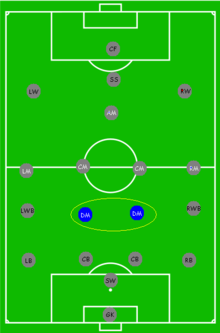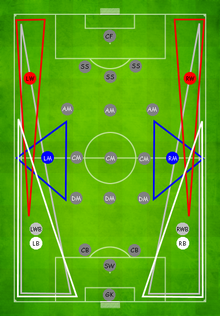Midfielder: Difference between revisions
Undid revision 203401728 by Jimbo online (talk)Why remove good examples? |
Jimbo online (talk | contribs) Undid revision 203404501 by Hubschrauber729 (talk Because they're not. Why add mediocre examples?) |
||
| Line 18: | Line 18: | ||
The defensive midfielder position is also referred to in Brazilian Portuguese as "volante" and in South American Spanish as "volante de marca" (Spanish & Portuguese for "[[Rudder]]" or someone who gives direction), and in Portugal as a "trinco" (meaning "lock"). Most Brazilian teams deploy at least one "volante" in their team, including the [[Brazil national football team|Brazilian national team]] who have fielded defensive midfielders, such as 1994 World Cup winning team captain [[Dunga]]. |
The defensive midfielder position is also referred to in Brazilian Portuguese as "volante" and in South American Spanish as "volante de marca" (Spanish & Portuguese for "[[Rudder]]" or someone who gives direction), and in Portugal as a "trinco" (meaning "lock"). Most Brazilian teams deploy at least one "volante" in their team, including the [[Brazil national football team|Brazilian national team]] who have fielded defensive midfielders, such as 1994 World Cup winning team captain [[Dunga]]. |
||
Accomplished defensive midfielders playing today include [[Claude Makelele]], [[Gennaro Gattuso |
Accomplished defensive midfielders playing today include [[Claude Makelele]], [[Gennaro Gattuso]] and [[Owen Hargreaves]]. |
||
The term "box to box" player (see below) is often used to refer to more dynamic defensive midfielders. |
The term "box to box" player (see below) is often used to refer to more dynamic defensive midfielders. |
||
| Line 26: | Line 26: | ||
Central midfielders play several roles on the field of play, and are probably the most important in terms of setting up attacks. Their position enables them to have an all-round view of the match, and as most of the action takes place in and around their area of the pitch, midfielders often exert the greatest degree of control over how a match is played. |
Central midfielders play several roles on the field of play, and are probably the most important in terms of setting up attacks. Their position enables them to have an all-round view of the match, and as most of the action takes place in and around their area of the pitch, midfielders often exert the greatest degree of control over how a match is played. |
||
Some players prefer to set up an attack from a withdrawn position, and are often coined ''deep-lying playmakers'', mainly because of their ability to spread play and dictate the game from a withdrawn position. Due to their weaknesses in their defensive aspects, some have to be supported by holding midfielders. Players in this mould include |
Some players prefer to set up an attack from a withdrawn position, and are often coined ''deep-lying playmakers'', mainly because of their ability to spread play and dictate the game from a withdrawn position. Due to their weaknesses in their defensive aspects, some have to be supported by holding midfielders. Players in this mould include [[Michael Carrick]], [[Andrea Pirlo]] and [[Xavi]]. |
||
==="Box-to-box" midfielders=== |
==="Box-to-box" midfielders=== |
||
| Line 32: | Line 32: | ||
Some central midfielders, nicknamed 'box-to-box' players, can play several roles in the game, depending on their particular strengths and the team tactics. They provide the link between defence and attack and can score and defend at either ends of the field. The most versatile of players, they typically possess exceptional stamina and are usually skilled at tackling, passing, shooting and keeping possession. |
Some central midfielders, nicknamed 'box-to-box' players, can play several roles in the game, depending on their particular strengths and the team tactics. They provide the link between defence and attack and can score and defend at either ends of the field. The most versatile of players, they typically possess exceptional stamina and are usually skilled at tackling, passing, shooting and keeping possession. |
||
Notable examples include [[Michael Ballack]], [[Patrick Vieira]], [[Steven Gerrard]], and [[Michael Essien]]. All are/were capable of scoring and defending from "box to box". This section of the field is often known as a team's "engine room", because great teams rarely succeeded without skillful, commanding central midfielders. |
Notable examples include [[Michael Ballack]], [[Roy Keane]], [[Patrick Vieira]], [[Steven Gerrard]], and [[Michael Essien]]. All are/were capable of scoring and defending from "box to box". This section of the field is often known as a team's "engine room", because great teams rarely succeeded without skillful, commanding central midfielders. |
||
== Attacking midfielder== |
== Attacking midfielder== |
||
| Line 43: | Line 43: | ||
[[Francesco Totti]], [[ |
[[Francesco Totti]], [[Paul Scholes]], [[Ronaldinho]], [[Juan Roman Riquelme]], and [[Kaká]] are attacking midfielders widely considered to be among the best today; other accomplished players include [[Cesc Fabregas]], [[Juninho Pernambucano]] and [[Andrés Iniesta]] |
||
==Winger ==<!-- This section is linked from [[David Beckham]] --> |
==Winger ==<!-- This section is linked from [[David Beckham]] --> |
||
Revision as of 09:10, 5 April 2008
- For the Australian Rules position, see Midfielder (Australian Rules).

In association football, a midfielder is a player whose position of play is midway between the attacking strikers and the defenders (highlighted in blue on the diagram). Their main functions are to dispossess (tackle) the opposing team, to retain possession of the ball, and to feed it to the strikers, and perhaps, to score as well. Some midfielders play a more defensive role, while others blur the boundaries between midfielders and strikers. The number of midfielders a team uses during a match may vary, depending on the team's formation and each individual player's role. The group of midfielders in a team is called the midfield.
Outstanding midfielders require a number of skills on top of fitness: they tackle, dribble, shoot, distribute and pass during any match. Most managers field at least one central midfielder with a marked task of breaking up opposition's attacks while the rest are more adept to creating goals or have equal responsibilities between attack and defense. At either side of the pitch a manager can field a winger, a specialist side midfielder used primarily for attack.
In essence, a good midfield must possess the ability to be combative whilst also being creative. A good striker without midfield support would lack attacking chances, while a defence likewise would be severely tested. Because they occupy the most influential parts of the pitch, midfielders are perhaps more likely to influence the outcome of a match than other positions, especially if they have vision for a good pass or ability to score.
Midfielders typically exhaust the most energy during a match due to the distance they cover on a pitch, as at times they can be called back into defense, or required to attack with the strikers.
Defensive midfielder

A defensive midfielder or a holding midfielder is a central midfielder who is stationed in front of the back defenders for defensive reasons, thus "holding back" the freedom of the opponents to attack. This specialist midfielder's responsibilities are to defend against or tackle the opposing team, to recover the ball for their team, and to safely distribute it to more attacking-minded players.
This is possibly one of the newest roles in modern football tactics. It is often likened to an evolved version of the old-school sweeper.
The defensive midfielder position is also referred to in Brazilian Portuguese as "volante" and in South American Spanish as "volante de marca" (Spanish & Portuguese for "Rudder" or someone who gives direction), and in Portugal as a "trinco" (meaning "lock"). Most Brazilian teams deploy at least one "volante" in their team, including the Brazilian national team who have fielded defensive midfielders, such as 1994 World Cup winning team captain Dunga.
Accomplished defensive midfielders playing today include Claude Makelele, Gennaro Gattuso and Owen Hargreaves.
The term "box to box" player (see below) is often used to refer to more dynamic defensive midfielders.
Central midfielders
Central midfielders play several roles on the field of play, and are probably the most important in terms of setting up attacks. Their position enables them to have an all-round view of the match, and as most of the action takes place in and around their area of the pitch, midfielders often exert the greatest degree of control over how a match is played.
Some players prefer to set up an attack from a withdrawn position, and are often coined deep-lying playmakers, mainly because of their ability to spread play and dictate the game from a withdrawn position. Due to their weaknesses in their defensive aspects, some have to be supported by holding midfielders. Players in this mould include Michael Carrick, Andrea Pirlo and Xavi.
"Box-to-box" midfielders
Some central midfielders, nicknamed 'box-to-box' players, can play several roles in the game, depending on their particular strengths and the team tactics. They provide the link between defence and attack and can score and defend at either ends of the field. The most versatile of players, they typically possess exceptional stamina and are usually skilled at tackling, passing, shooting and keeping possession.
Notable examples include Michael Ballack, Roy Keane, Patrick Vieira, Steven Gerrard, and Michael Essien. All are/were capable of scoring and defending from "box to box". This section of the field is often known as a team's "engine room", because great teams rarely succeeded without skillful, commanding central midfielders.
Attacking midfielder

An attacking midfielder is any midfielder who is stationed in a more advanced midfield position to assist goalscoring.
The attacking midfielder is an influential position and requires the player to possess good technical abilities, an eye for a pass, shooting, running, and dribbling skills. The attacking midfielder is similar to the playmaker role.
He is typically the offensive pivot of the team; if it is in a centralised position, sometimes known in football as "playing in the hole", although this term can also be used to describe a deep-lying centre forward. This specialist midfielder's main role is to create goal-scoring opportunities for his own team, and perhaps to score himself.
Francesco Totti, Paul Scholes, Ronaldinho, Juan Roman Riquelme, and Kaká are attacking midfielders widely considered to be among the best today; other accomplished players include Cesc Fabregas, Juninho Pernambucano and Andrés Iniesta
Winger

A winger is a midfielder who is stationed in a wide position near the touchlines. Wingers such as Stanley Matthews or Jimmy Johnstone used to be classified as forwards in traditional W-shaped formations, and were formally known as "Outside Right" or "Outside Left," but as tactics evolved through the last 40 years, wingers have dropped to deeper field positions. Wingers are now classified as part of the midfield, usually in 4-4-2 or 4-5-1 formations (but whilst the team is on the attack, they tend to resemble 4-2-4 and 4-3-3 formations respectively).
It is a winger's duty to beat opposing fullbacks and to deliver cut-backs or crosses from wide positions. They are usually some of the quickest players in the team and usually have very good dribbling skills as well. Today, some of the best examples are Cristiano Ronaldo, Lionel Messi, Franck Ribery, Ryan Giggs, and David Beckham.
Traditionally wingers were purely attacking players who hugged the touch line and were not expected to track back and defend. This began to change around the time of the 1966 World Cup, when England manager Alf Ramsey led a team without natural wingers to the championship. This team was known as the "Wingless Wonders".
This has led to most modern wingers having a more demanding role in the sense that, they are expected to defend and track back to repossess the ball as well as provide skillful crosses for centre forwards and strikers. Sometimes, they are also expected to cover/attack the central area, as well as switch flanks. Technically gifted wingers such are able to dribble infield and using a plethora of tricks, pass defenders and shoot or set up a teammate.
